Constructive Dismissal Resignation Letter
[Your Name]
[Your Address]
[City, State, ZIP Code]
[Email Address]
[Phone Number]
[Date]
[Employer's Name]
[Company Name]
[Company Address]
[City, State, ZIP Code]
Dear [Employer's Name],
I am writing this letter to officially resign from my position as [Your Job Title] at [Company Name], effective [Last Working Day], due to what I believe constitutes constructive dismissal. It is with a heavy heart that I find myself compelled to take this course of action, as I have always valued my role within the company and my working relationship with my colleagues.
Over the course of the past [time period], I have experienced a series of actions and conditions that have made my work environment increasingly untenable and have had a significant impact on my professional well-being. The cumulative effect of these issues has left me with no choice but to resign from my position.
I would like to outline the specific incidents and factors that have contributed to my decision:
1. Unreasonable Changes to Job Duties: [Explain any significant changes to your job responsibilities that were not agreed upon, and how they have negatively affected your ability to perform your role effectively.]
2. Hostile Work Environment: [Describe any instances of harassment, discrimination, or bullying that you have experienced or witnessed, and how they have affected your working conditions and morale.]
3. Lack of Support and Resources: [Explain any situations where you have not received the necessary support, training, or resources required to perform your job effectively, despite raising concerns about it.]
4. Breach of Contract: [If there have been any breaches of your employment contract, mention them here and how they have impacted your employment.]
5. Failure to Address Concerns: [Indicate any attempts you made to address these issues with management or HR and how they were not adequately addressed or resolved.]
I believe that these circumstances, taken together, constitute constructive dismissal, which has led me to feel forced to resign from my position. Despite my efforts to resolve these issues, I have not seen any substantial improvements, and my working conditions have become unbearable.
I am grateful for the opportunities I have had during my time at [Company Name], and I am proud of the contributions I have made to the team. However, I firmly believe that my professional growth and well-being are being hindered by the current situation.
In compliance with the notice period stated in my employment contract, I am willing to work until [Last Working Day], providing sufficient time for the company to find a suitable replacement. Please consider this letter as my official notice of resignation.
I request that all dues, including salary for the notice period, any outstanding payments, and any applicable benefits, be settled promptly as per the company's policies and employment laws.
I am open to having an exit interview to discuss my experiences further, should the company find it appropriate.
Thank you for your understanding in this matter. I hope that the issues raised in this letter can serve as valuable feedback for the company to improve its work environment and employee well-being in the future.
Yours sincerely,
[Your Name]
Formal Constructive Dismissal Resignation Letter
Subject: Resignation Due to Constructive Dismissal
Dear [Manager's Name],
I am writing to formally resign from my position as [Your Position] with [Company Name], effective immediately. Due to the significant changes in my working conditions and treatment that fundamentally breach my contract and professional standards, I am compelled to resign.
I have made every effort to address these issues internally, but the circumstances remain untenable. I regret that it has come to this, but I believe this action is necessary to protect my professional and personal well-being.
Sincerely,
[Your Name]
Heartfelt / Personal Constructive Dismissal Letter
Dear [Manager's Name],
It is with deep regret that I tender my resignation from [Company Name] due to circumstances that have made my continued employment impossible. Despite my dedication and loyalty, the changes in my role and working conditions have forced me into a position where I cannot continue without compromising my principles.
I hope the company will understand the seriousness of these concerns and address them for the well-being of other employees.
Thank you for the opportunities I have had.
Sincerely,
[Your Name]
Professional / Legal Tone Constructive Dismissal Letter
Subject: Resignation Due to Constructive Dismissal
Dear [Manager's Name],
I hereby submit my resignation from [Company Name], effective [Date], due to constructive dismissal. The changes in my employment terms, including [specific breaches or changes], have significantly altered the essential terms of my contract.
I have attempted to resolve these matters internally; however, the unresolved issues leave me with no alternative but to resign. Please consider this letter as formal notice, and I request written acknowledgment of my resignation.
Sincerely,
[Your Name]
Quick / Simple Constructive Dismissal Letter
Dear [Manager's Name],
I am resigning from my role as [Position] at [Company Name] effective immediately. The working conditions have become unacceptable and constitute constructive dismissal.
Thank you for your understanding.
Best regards,
[Your Name]
Provisional / Conditional Constructive Dismissal Letter
Dear [Manager's Name],
I am submitting my resignation effective [Date], contingent upon confirmation that the issues I have raised, including [specific issues], are not resolved. The current working conditions have significantly breached the terms of my contract, leaving me with no viable alternative.
I hope that my concerns are taken seriously, although I must proceed with formal resignation to protect my professional interests.
Sincerely,
[Your Name]
Formal but Firm Constructive Dismissal Letter
Subject: Notice of Resignation Due to Constructive Dismissal
Dear [Manager's Name],
I am compelled to resign from my position at [Company Name] effective immediately due to a constructive dismissal situation. The consistent changes to my job responsibilities, coupled with [specific incidents], have created a work environment that is untenable.
I request that my resignation be formally acknowledged and that all due entitlements be processed in accordance with my contract.
Sincerely,
[Your Name]
What / Why a Constructive Dismissal Resignation Letter Is Needed
- Used when employment terms are significantly breached by the employer.
- Serves as a formal notice while documenting legal grounds for constructive dismissal.
- Protects the employee’s rights and entitlements in potential legal or HR proceedings.
Who Should Send a Constructive Dismissal Resignation Letter
- Employees facing significant contract breaches or hostile working conditions.
- Professionals seeking formal documentation for legal or HR purposes.
- Individuals who have attempted internal resolution but cannot continue under the current conditions.
Whom the Letter Should Be Addressed To
- Direct manager or supervisor responsible for the employee.
- Human Resources department for formal record keeping.
- Senior management if the issue involves higher-level decisions.
When to Send a Constructive Dismissal Resignation Letter
- After repeated breaches or changes in contract terms.
- When attempts to resolve issues internally fail.
- Immediately upon recognizing that working conditions are untenable or unlawful.
How to Write and Send a Constructive Dismissal Resignation Letter
- Clearly state your position and resignation date.
- Specify the reasons for constructive dismissal without excessive emotional language.
- Mention any attempts to resolve the issues internally.
- Keep a professional and factual tone.
- Send via email and/or physical letter with acknowledgment of receipt if possible.
Requirements and Prerequisites Before Writing
- Documented evidence of breaches or adverse changes to your employment.
- Records of communication or complaints submitted to management.
- Understanding of contractual terms and legal definitions of constructive dismissal.
- Optional: seek legal advice before sending to ensure rights are protected.
Formatting Guidelines for Constructive Dismissal Letters
- Tone: Formal, professional, and factual.
- Length: 1–2 pages maximum; concise yet detailed.
- Structure: Subject, greeting, reason for resignation, factual explanation, request for acknowledgment, closing.
- Etiquette: Avoid emotional or accusatory language; focus on facts.
- Mode: Email for speed, printed letter for official record.
After Sending / Follow-up Actions
- Request written acknowledgment of receipt.
- Keep a copy for personal and legal records.
- Monitor the processing of final payments, benefits, or entitlements.
- Be prepared to engage HR or legal advisors if disputes arise.
Pros and Cons of Sending a Constructive Dismissal Letter
Pros:
- Provides formal documentation for legal protection.
- Ensures clear communication of resignation grounds.
- May trigger internal resolution or prompt policy review.
Cons:
- Could escalate tension with the employer.
- May impact references if not handled professionally.
- Potential legal complexity if employer disputes claims.
Tricks and Tips for Constructive Dismissal Letters
- Stick to factual, verifiable incidents.
- Avoid blaming or emotional language.
- Keep a copy of all related correspondence.
- Seek advice from HR or a legal professional if unsure.
- Mention prior attempts to resolve issues without threat or anger.
Common Mistakes to Avoid
- Writing a letter while overly emotional or angry.
- Failing to document specific breaches or incidents.
- Using vague or unsupported claims.
- Not requesting acknowledgment of receipt.
- Sending without understanding legal or contractual implications.
Elements and Structure of a Constructive Dismissal Letter
- Introduction: Clearly state resignation and effective date.
- Reason for Resignation: Describe breaches or adverse working conditions.
- Factual Details: Provide concise, verifiable examples of incidents.
- Attempts to Resolve: Document prior communication or complaints.
- Closing Request: Ask for acknowledgment and outline expectations for final payments.
- Sign-Off: Professional and polite.
- Attachments (Optional): Copies of prior complaints, evidence, or supporting documentation.
Compare and Contrast with Regular Resignation Letters
- Regular Resignation: Typically voluntary and amicable, no dispute with employer.
- Constructive Dismissal: Due to employer’s actions; may involve legal grounds.
- Key Difference: Documentation of breaches and factual justification.
- Alternative Actions: Internal complaint, mediation, or HR resolution before resigning.
Does it Require Attestation or Authorization
- Generally does not require employer authorization but must be acknowledged for record.
- Legal or HR documentation may need signatures confirming receipt.
- Legal advice or notarization may be useful for evidence in disputes.

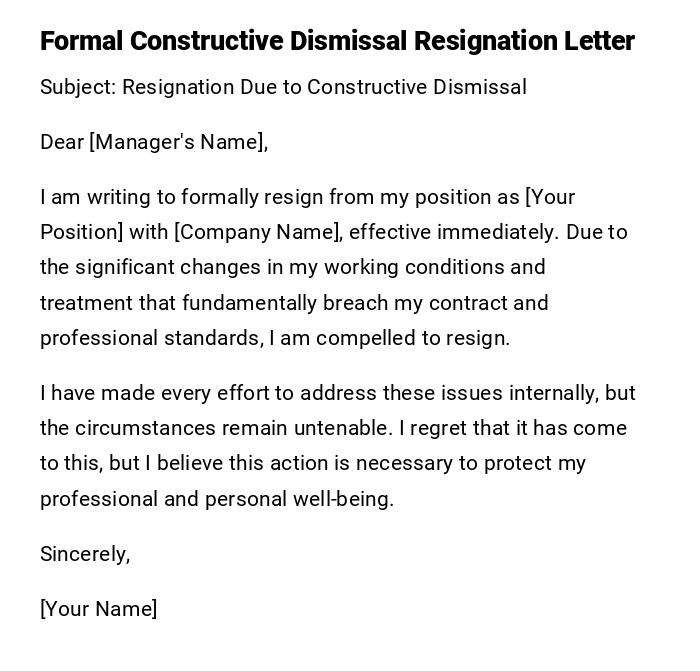
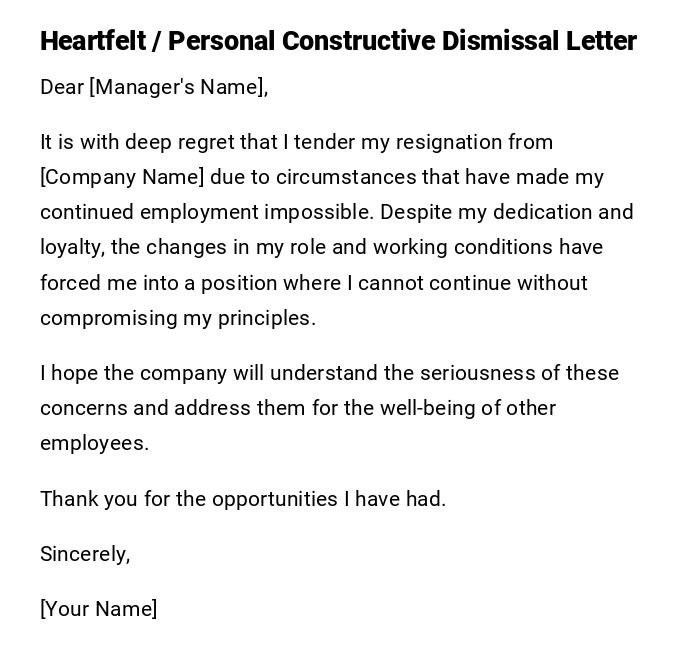
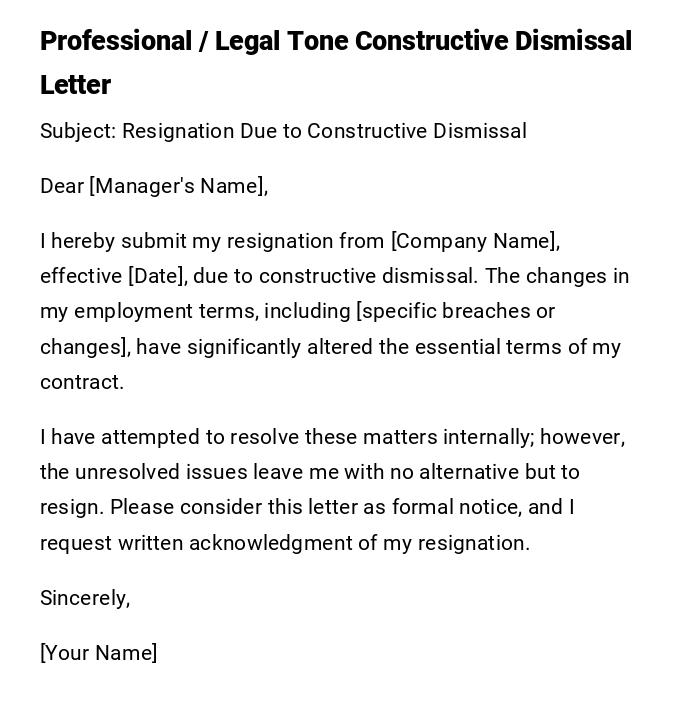
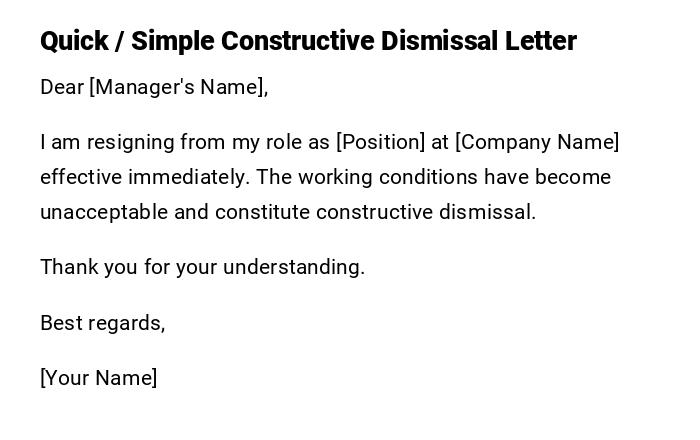
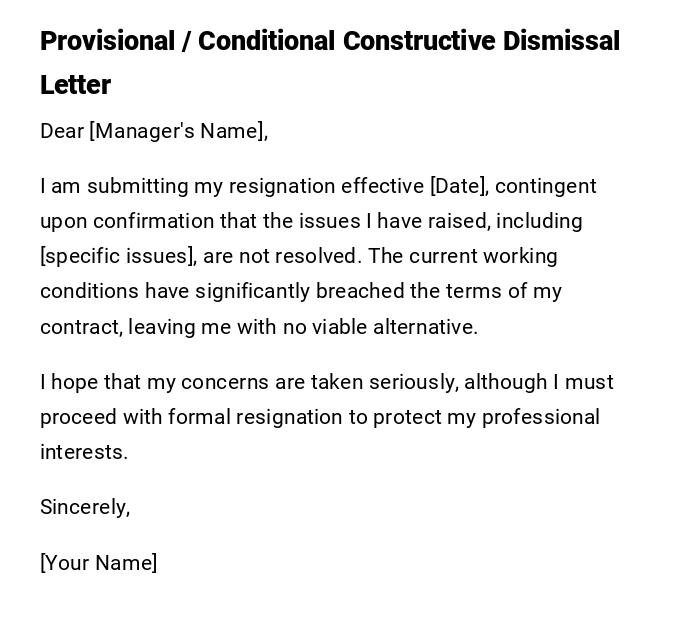
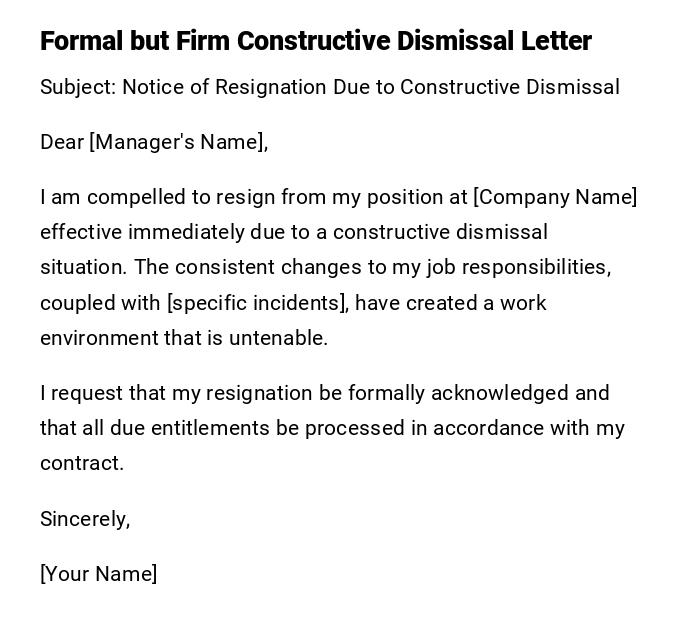

 Download Word Doc
Download Word Doc
 Download PDF
Download PDF